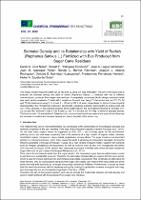| dc.contributor.author | Cruz Nieto, Dante D. | |
| dc.contributor.author | Rodriguez Espinoza, Ronald F. | |
| dc.contributor.author | Legua Cárdenas, José A. | |
| dc.contributor.author | Ipanaqué Roña, Juan M. | |
| dc.contributor.author | Ramos Pacheco, Ronald L. | |
| dc.contributor.author | Abarca Rodriguez, Joaquin J. | |
| dc.contributor.author | Natividad Huasupoma, Delicias E. | |
| dc.contributor.author | Fernández Herrera, Fredesvindo | |
| dc.contributor.author | Zapata del Solar, Helen A. | |
| dc.date.accessioned | 2023-08-02T15:07:28Z | |
| dc.date.available | 2023-08-02T15:07:28Z | |
| dc.date.issued | 2022-12-15 | |
| dc.identifier.uri | https://hdl.handle.net/20.500.13067/2536 | |
| dc.description.abstract | The impact of agro-industrial waste can be reduced by using it in crop fertilization. The aim of this study was to evaluate the stomatal density and yield of radish (Raphanus Sativus L.) fertilized with biol at different concentrations, produced from sugar cane residues. A completely randomized blocks design statistical model was used, which consisted of 5 tests with 3 repetitions for each one, being T1 the control trial, and T2, T3, T4 and T5 the treatments using 2, 3, 4 and 5 L of biol in 200 L of water respectively. In terms of crop physical characteristics, the T5 treatment excelled in plant length, equatorial diameter, plant weight, as well as yield with 12.71 t/ha. Likewise, in the chemical analysis of the radish leaves, the T5 treatment showed an increase in K, Ca, Zn and MN, while the T2 did it in N, P and Cu, the T3 in Fe and the T4 in Mg. In terms of stomatal density, T5 stood out with 122 stomatal/mm2. Based on this, it is concluded that the increase in the dose of biol influences the increase in nutrient and stomatal density and hence the yield of the radish crop. | es_PE |
| dc.format | application/pdf | es_PE |
| dc.language.iso | eng | es_PE |
| dc.publisher | AIDIC The Italian Association of Chemical Engineering | es_PE |
| dc.rights | info:eu-repo/semantics/openAccess | es_PE |
| dc.rights.uri | https://creativecommons.org/licenses/by-nc-nd/4.0/ | es_PE |
| dc.subject | Sugar Cane Residues | es_PE |
| dc.title | Stomatal Density and its Relationship with Yield of Radish (Raphanus Sativus L.) Fertilized with Biol Produced from Sugar Cane Residues | es_PE |
| dc.type | info:eu-repo/semantics/article | es_PE |
| dc.identifier.journal | Chemical Engineering Transactions | es_PE |
| dc.identifier.doi | https://doi.org/10.3303/CET2297096 | |
| dc.subject.ocde | https://purl.org/pe-repo/ocde/ford#2.11.04 | es_PE |
| dc.publisher.country | PE | es_PE |
| dc.relation.url | https://www.cetjournal.it/index.php/cet/article/view/CET2297096 | es_PE |
| dc.source.volume | 97 | es_PE |
| dc.source.issue | 2022 | es_PE |
| dc.source.beginpage | 571 | es_PE |
| dc.source.endpage | 576 | es_PE |


